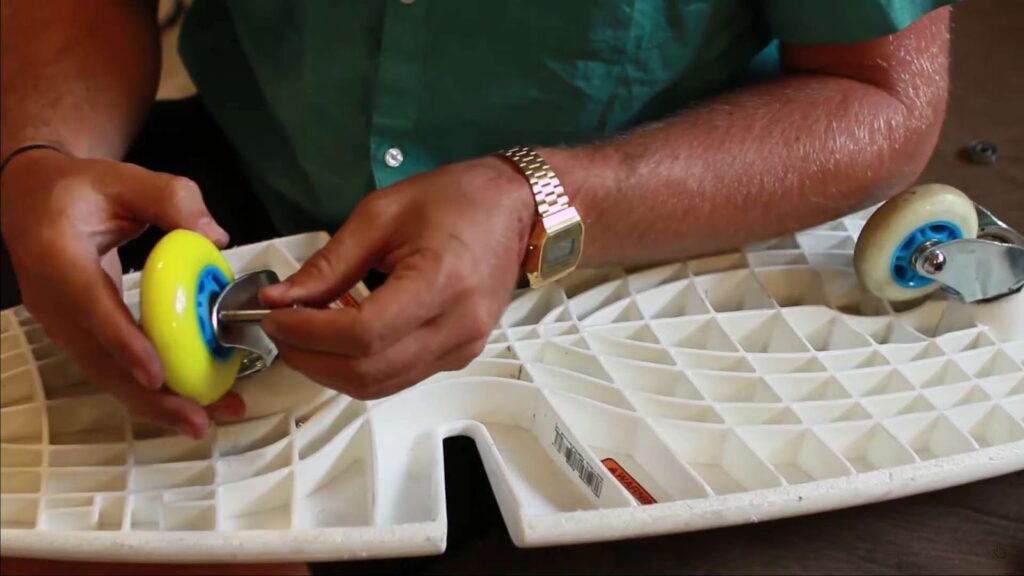Vigilant observation of your wheels’ wear patterns and a corresponding rotation strategy are paramount. Consistently rotating your wheels will yield several benefits, including heightened safety, an extended wheel lifespan, and, in the end, a superior skating adventure.
Numerous factors can contribute to wheel wear, with some of the most prevalent ones being:
- The techniques and frequency of turning and braking;
- The characteristics of the skating surface;
- The quality of your wheels, encompassing both the urethane and hub;
- Your individual body weight as a skater;
- How often you engage in wheel rotation;
- The frequency of your skating outings.
Maximizing Wheel Longevity through Effective Rotation
Your skateboard wheels are like the tires of a car, essential for a smooth and enjoyable ride. Ensuring the longevity of your wheels is not only cost-effective but also contributes to your safety and overall skating experience. One crucial maintenance task that often gets overlooked is wheel rotation. Properly rotating your wheels helps maintain a consistent wear pattern, which, in turn, extends the life of your wheels and provides a smoother ride. In this comprehensive guide, we’ll delve into the why, when, and how of wheel rotation, offering tried-and-true techniques and valuable tips for skaters of all levels.
Understanding Wheel Wear Patterns
Before we dive into the specifics of wheel rotation, let’s grasp the concept of wear patterns. Your wheels don’t wear uniformly; they exhibit distinctive patterns based on your skating habits. Typically, the front wheels wear out faster than the rear ones. This discrepancy arises from the way skaters turn, stop, and distribute their weight on the board. Understanding these tendencies is the first step towards effective wheel maintenance.
When to Rotate Your Wheels
Knowing when to rotate your wheels is crucial for maintaining optimal performance. Here’s a general guideline:
- For three-wheeled skates:
- Swap the front wheels on one skate with the middle wheel on the opposite skate;
- Exchange the back wheels between the two skates.
- For four-wheeled skates:
- Take the first two wheels on the left skate and switch them with the back two wheels on the right skate;
- Repeat the process for the remaining four wheels.
Pro Tips for Wheel Rotation
- Aim to rotate your wheels regularly, ideally every few weeks or when you notice uneven wear patterns;
- Pay close attention to the wear on each wheel, as sometimes only one or two wheels may require rotation;
- Keep a rotation schedule or set reminders to ensure you don’t forget this essential maintenance task;
- Consider investing in a specialized wheel rotation tool, which can make the process even more efficient.
Wheel Washing for Peak Performance
Taking your wheel maintenance to the next level involves wheel washing. Cleaning your wheels during rotation not only extends their lifespan but also keeps your bearings free from grime and build-up. Here’s a step-by-step guide:
- Remove the wheels from the frames and set aside the axles and bearings (avoid washing these components);
- Fill a container with warm water and dishwashing soap, creating a gentle cleaning solution;
- Use a soft rag or cloth to tumble the wheels in the soapy water. Be cautious not to use water that is too hot, and avoid letting the wheels soak for an extended period, as this can deform the urethane;
- Rinse the wheels thoroughly with clean water to remove any soap residue;
- Allow the wheels to air dry completely before reassembling them onto your skateboard.
By incorporating these wheel rotation and cleaning techniques into your skateboard maintenance routine, you’ll not only prolong the life of your wheels but also enjoy a smoother and safer ride every time you hit the pavement. Happy skating!
Identifying the Right Time for Wheel Replacement
Recognizing Wear and Tear Indicators:
When it comes to maintaining the optimal performance of wheels, it’s crucial to be vigilant about signs of deterioration. Key indicators include the presence of substantial urethane erosion, visible fractures in the wheel hub, or the formation of a pronounced point at the center of the wheel, often resulting from uneven wear. These signs not only compromise the quality of the ride but also pose safety risks. Ignoring these signals can lead to decreased performance, increased noise, and a generally uncomfortable riding experience.
Enhancing Performance Through Timely Replacement:
Regular inspection and timely replacement of wheels can significantly enhance the riding experience. Not only does it ensure smoother and quieter rides, but it also contributes to the longevity of the equipment.
Strategies for Wheel Maintenance:
- Regular Inspection: Frequently check for signs of wear, such as cracks or significant urethane loss;
- Performance Monitoring: Be aware of any changes in ride quality, such as increased noise or vibration;
- Safety First: Prioritize replacing wheels at the first sign of a sharp tip or hub damage to prevent accidents.
Wheel Replacement Strategies for Different Rider Levels
- Experienced Riders: Skaters with more experience typically develop a routine of rotating their wheels regularly. This practice leads to more uniform wear, often resulting in the need to replace only a few wheels at a time. This not only saves costs but also maintains consistent performance;
- Beginners and Casual Riders: Newcomers or those who don’t rotate their wheels regularly tend to experience uneven wear. This often necessitates replacing the entire set of wheels simultaneously. While this might be more costly, it ensures balanced performance and safety.
Understanding Your Skate’s Wheel Size Compatibility
Assessing Frame Specifications for Wheel Sizing:
To ascertain the appropriate wheel size for your skates, a crucial starting point is examining the skate frame. Skate frames are typically marked with the maximum wheel size they can accommodate. This information is often found inscribed on the side of the frame. In situations where the frame lacks this detail, an effective alternative is to research the skate model online. This can be done through manufacturer websites or skate forums, where specific skate models and their specifications are frequently discussed.
Key Considerations When Selecting Wheel Size:
- Smaller Wheel Size Risks:
- Gaps in Frame: Choosing a wheel size smaller than your frame’s capacity can lead to the formation of gaps. These gaps may trap small debris like rocks and sticks, posing a risk to smooth skating;
- Brake Height Adjustment: A smaller wheel will lower the skate’s brake. This adjustment can make braking more challenging and potentially hazardous.
- Larger Wheel Size Dangers:
- Clearance Issues: Opting for a wheel size that surpasses your frame’s maximum can lead to insufficient clearance. Without adequate space, the wheel cannot rotate freely, which can hinder skating performance and even damage the frame.
Helpful Tips for Wheel Replacement:
Verify Frame Size: Always double-check the maximum wheel size indicated on your skate’s frame.
- Research Online: If the frame information is missing, use online resources such as manufacturer sites or skating forums for guidance;
- Seek Professional Advice: If in doubt, consulting a professional at a skate shop can provide personalized advice based on your specific skate model;
- Consider Skating Style: Remember, wheel size can affect your skating experience. Larger wheels are generally faster but less maneuverable, suitable for speed skating. Smaller wheels offer more control, ideal for tricks and tight turns;
- Safety First: Prioritize safety by ensuring that the wheel size does not compromise the skate’s braking mechanism or lead to unwanted debris collection.
By paying close attention to these factors, skaters can ensure they select the most suitable and safe wheel size for their skating needs, enhancing both performance and safety on the rink or road.
Upgrading Your Skate Wheels: A Step-by-Step Guide
Is it time to give your skating experience a refreshing boost? Perhaps your old wheels are worn out, or you simply want to switch things up with a new set of skate wheels. Whatever your reason, changing or removing skate wheels is a straightforward process that can significantly impact your skating performance. In this comprehensive guide, we’ll walk you through the steps to effortlessly upgrade your skate wheels, ensuring a smoother, more enjoyable ride.

1. Gather Your Tools
Before diving into the wheel replacement process, make sure you have the necessary tools at your disposal:
- Allen wrench (typically 5mm or 4mm depending on your skate model);
- Having these tools handy will streamline the process and ensure you can tackle each step without interruption.
2. Front Wheel Removal
Begin by removing the front wheel. Follow these steps:
- Locate the axle bolts on the front wheel;
- Using the appropriate Allen wrench size, unscrew and remove the axle bolts. Place them in a safe spot to avoid misplacement;
- With the bolts removed, gently pull the front wheel out of the wheel frame. You should now have the old wheel in hand.
3. Disassembling the Wheel
Now, let’s disassemble the old wheel. This step involves removing the bearings and spacer, ensuring all components come out together. Here’s how to do it:
- Carefully slide out the bearings and spacer from the old wheel;
- Inspect the bearings for any signs of wear or damage. If they are in poor condition, it’s an excellent opportunity to replace them for improved performance;
- Clean the bearings and spacer using a degreaser or bearing cleaner. This step is essential to ensure optimal performance and longevity.
4. Preparing the New Wheel
With the old wheel disassembled, it’s time to prepare the new wheel. Follow these steps:
Place the cleaned spacer and bearings into the new wheel. Make sure they fit snugly.
5. Installing the New Wheel
Now that your new wheel is prepped, it’s time to install it onto the wheel frame. Follow these steps:
- Slide the new wheel into the wheel frame, aligning it properly;
- Ensure the bearings and spacer fit securely within the new wheel.
6. Axle Tightening and Adjustment
Proper axle tightening is crucial to your skating experience. Here’s how to do it:
Replace the axle bolts into the wheel assembly. Using the Allen wrench, tighten the axle. The tightening technique may vary depending on your spacer material:
- If your spacer is aluminum, tighten the axle as far as it will go;
- If your spacer is plastic, tighten the axle almost as far as it will go, then loosen it slightly;
- Spin the wheel to check how freely it rolls. If there’s resistance, loosen the axle. If the wheel wobbles, tighten the axle accordingly.
7. Repeat the Process for Remaining Wheels
You’re almost there! Now, simply repeat the same process for the remaining wheels on your skates to ensure consistency in your skating experience. Remember to check the tightness and alignment of each wheel as you go.
By following these comprehensive steps, you’ll not only change or remove your skate wheels but also optimize your skating performance. Enjoy the smooth, thrilling ride with your newly upgraded skate wheels! Read about the ultimate showdown: Zuperior vs. Quad Profile! Uncover their unique features and find your perfect match in this insightful comparison.
Conclusion
In conclusion, possessing the knowledge of correctly managing the rotation of inline skate wheels and recognizing the opportune moment to replace them stands as a fundamental aspect in preserving the efficiency, safety, and durability of your inline skates. Engaging in regular wheel rotation facilitates the even distribution of wear, thus prolonging the lifespan of your wheels and ensuring a smoother and more pleasurable skating experience. Furthermore, a keen awareness of the telltale signs of wheel deterioration and the right moment for replacement is paramount for your safety, as worn-out wheels can result in diminished traction and stability.
It is imperative to adhere to the recommended rotation patterns tailored to your specific skate configuration and diligently monitor the wear indicators on your wheels. Investing in top-notch replacement wheels when the time arises not only elevates your skating performance but also affords superior control while mitigating the risk of accidents.
By steadfastly adhering to these guidelines, you can relish your inline skating escapades to the fullest extent, simultaneously upholding the well-being and performance of your skates. Therefore, take the initiative to nurture your wheels, ensuring a safe and stylish journey through the streets and trails, all while rolling with unwavering confidence.









